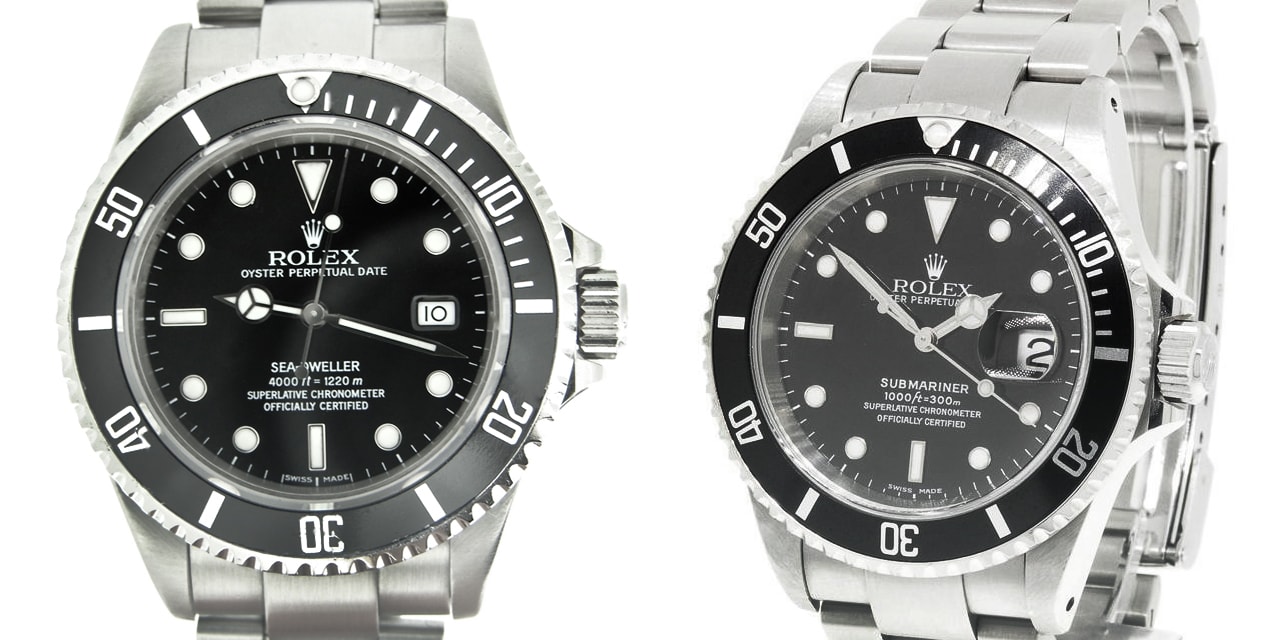The History of Rolex Dive Watches
They may not be able to claim to have invented the very first dive watch—that honor really goes to Blancpain and their Fifty Fathoms—but Rolex has, by any measure, produced some of the most iconic.
Founded in 1905, the company was instrumental in transforming the image of the wristwatch, from a fragile piece of jewelry meant solely for women, into an essential accessory for men. And the biggest leap forward in that revolution was their invention of the Oyster case in 1926.
With its submarine hatch-like construction, the hermetically sealed Oyster was the original waterproof housing, providing enough protection for the delicate movement components to allow watches to be worn in the most challenging environments.
Long before the days of recreational, or even military, diving, Rolex was already paving the way for others to follow.
Rolex’s First Dive Watch
By the 1950s, sport Scuba diving was a massively popular pastime. Technology perfected during the war had started to permeate into civilian life, and personalities such as Jacques Cousteau were pioneering underwater exploration, opening it up to the public with his development of the Aqualung.
A close friend of Cousteau, Rolex board member René Paul Jeanneret, was himself a passionate diver and worked to persuade the manufacturer to design their own model to be worn in the depths.
However, this being Rolex, merely being waterproof wouldn’t be enough. Realizing even the most committed frogman had to come up for air eventually, the piece Jeanneret wanted also had to be stylish enough to wear everyday, on top of its inherent strength and resilience.
At the Basel Fair in 1953, Rolex unveiled their creation, the only watch in the world to be water resistant to 100m; the Submariner.
An immediate and unqualified success when it officially went on sale the following year, its styling, with the handsomely legible dial and especially the black rotating bezel to help record elapsed time, caught the imagination perfectly. It is a visual that has been emulated, paid homage to and downright copied by almost every other watchmaker out there at one time or another.
Yet Rolex was not finished with the Sub by a long way. By the end of the decade it had been released in a total of nine different references as the brand worked to refine the watch. One example, the ref. 6538, was even waterproof to 200m. Known colloquially as the Big Crown, or Bond Sub (after its starring role on Sean Connery’s wrist in Dr. No) it featured an 8mm winding crown and is now among the most sought after vintage models on the preowned market.
But in 1959 the biggest change to the Submariner in its short life took place, in the shape of the ref. 5512. This was the reference to introduce crown guards and a new, larger 40mm case.
Even though the watch would continue to be updated with new movements and materials during its decades of production, it would keep the 5512’s fundamental silhouette for the next 50-years.
The next major upheaval occurred in 1967, when the Sub range essentially split in two. The ref. 1680 was the first to include a date function, covered by Rolex’s patented Cyclops crystal. For many fans, the ref. 1680 marks the point where the Submariner stopped being the ultimate tool watch and completed its conversion into a status symbol. In truth, it was already being worn by far more desk divers than the real thing, but the new addition strongly divided opinions, with some complaining that the window at the three o’clock, and particularly the magnifying lens over the top, ruined the overall symmetry of the dial.
Reacting to the comments, Rolex simply decided to make both types, and there have been date and no-date Submariners ever since.
As it turns out, the purists may have had a point. The date Subs have gone on to be released in both Rolesor and solid gold models, along with a variety of different colorways, all taking it further away from its roots. The no-date examples have remained an only steel option, and always with black dial and bezel.
Today, both are still just about the most popular Rolex watches in the portfolio, and are often the first port of call for budding collectors. One of the few models that can genuinely be described as legendary, the Submariner has been way out in front for generations
Rolex Dives Deeper
Although the Sub had proved itself tough enough for recreational divers and even the British Royal Navy, who had been issuing it to their teams since 1954 (and who were responsible for a redesign of the bezel so that it overhung the case), by the mid 60s, something even more durable was needed.
Professional saturation divers were required to work at extraordinary depths, living in underwater habitats for extended periods of time. There, they would be breathing a carefully controlled gas mixture, which included a large proportion of helium. With the smallest molecules of any gas, helium bubbles would easily seep inside the divers’ watches, most usually Submariner ref. 5513 models (the non-chronometer version of the ref. 5512, with 200m water resistance) and even an Oyster case proved powerless to keep them out.
In themselves, the bubbles caused no problems when the crews remained under pressure. But once they started their ascent back to the surface, the pressure would be reduced, the bubbles would expand and they would blow the crystal coverings off the dial.
The world’s leading commercial dive operators, COMEX, collaborated with Rolex on a design to find the solution, which led to the invention of the HEV, or Helium Escape Valve.
First retrofitted onto a ref. 5513 (making the ref. 5514) the HEV was a small one-way regulator in the side of the case at the nine o’clock which allowed for the gas to escape before it could damage the watch.
When tests were completed successfully, an all-new dive model was created, with a thicker case and crystal, that could endure the life of a saturation diver and accommodate the HEV. Rolex named it the Sea-Dweller.
The first, the ref. 1665 (better known as the Double Red Sea-Dweller or DRSD) was launched in 1967 and was waterproof to an extraordinary 2,000ft, or 610m. By the end of the 70s, that had doubled to 4,000ft with the ref. 16660, or Triple Six.
In terms of popularity, there is not that much to choose between the Sea-Dweller and the Submariner. Both are clearly from the same design book, but even though very few are going to push either to their limits, many people opted for the Sea-Dweller over the Sub due to its more tool-like nature. It may have had a date display, but it, crucially, didn’t have a Cyclops. It was also only available in steel, with none of the precious metal finery which its smaller brother had picked up.
That applies to the vintage examples anyway. Recent years have seen Rolex bring out a yellow Rolesor Sea-Dweller to run alongside the stainless model, and also fit a lens over the date. The case size has increased as well, up to 43mm over the former 40mm.
They are changes which have been applauded by some and bemoaned by others, but the fact remains the Sea-Dweller is possibly the most accomplished all round dive watch on the market at the moment. Impossibly robust and elegantly stylish at the same time, it is the best of both worlds.
Rolex Dives Deeper…Again
While the idea of a watch that could survive 4,000ft underwater would be enough for some, at Rolex they had other ideas.
In 2008, the brand took the remarkable step of retiring fan favorite the Sea-Dweller, and replacing it with a watch that looked somewhat similar but was, in fact, on another level completely.
As it turns out, that level was 12,800ft—as-near-as-makes-no-difference two and a half miles, straight down.
Very aptly named the Deepsea, it is the culmination of everything the manufacturer has learned in their 60+ year relationship with diving pioneers.
Building a watch that can withstand pressures of around 5,500lbs per square inch, while remaining a wearable size, pushed the limits of even Rolex’s technicians. It could have been done with a ludicrously oversize case, but on the outside, the Deepsea is recognizably of the same ilk as the brand’s other two divers.
That called for some ground-breaking engineering, resulting in the Ringlock System.
Consisting of a crystal measuring 5.5mm thick, along with a case back made from grade 5 TA6V titanium designed to bend under stress, key to it all is an encircling central ring formed from BioDur 108. A nitrogen-alloy steel, it is three times stronger than even the 904L steel used across the rest of the collection. That metal band redistributes the unfathomable weight pressing down on the Deepsea around the circumference of the watch and onto the flexible two-part case back.
It all adds up to a model around 10 percent slimmer than something with its abilities should be.
However, this is not a small watch. At 44mm in diameter and 17.7mm thick, it is the largest in Rolex’s catalog. That makes it more niche than either of the others in their dive group, unlikely to be worn with too many dress shirts.
Recognizing this, the brand took the hugely welcomed decision to reinstate the Sea-Dweller in 2014.
Today, the trio is back together. As you would expect, the original, the Submariner, offers the most choice in different styles. All 40mm examples, with the brand’s Supercase, you can take your pick from versions in both white or yellow gold, as well as two-tone models and stainless steel. Colors vary from traditional black to bright green and a beautiful deep blue, with each one’s bezel now Cerachrom.
The Sea-Dweller, in its new 43mm size, comes in steel or yellow Rolesor with black dials, while the Deepsea has two faces to choose from—black or what Rolex calls the D-Blue.
Made to commemorate director James Cameron’s record-breaking solo descent to the lowest point on earth, Challenger Deep in the Mariana Trench, the D-Blue is the brand’s first and only split tone dial, starting a brilliant blue at the top and blending to a deep black at the bottom; a pictorial representation of the descent into the immense depths.
Rolex are really the last word in luxury dive watches. Their legacy of innovation is second to none, and the result has been three models that are at once iconic and capable of amazing feats.
But beyond that, the aesthetic designs mean even those with no interest in exploring the underwater realm can use them everyday—safe in the knowledge they are wearing models which can survive just about anything.
— Featured Photo Credit: BeckerTime’s Archive.





